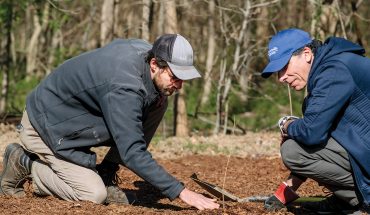How a community works together with volunteers, nonprofits and more to help families in need make their house a home
by Hampton Williams Hofer | photography by Bob Karp

Tiffany Lyons spent last Christmas in a small hotel room with her four young children. There was nowhere to cook a meal or set up a Christmas tree. The family was fleeing crisis, waiting for an affordable apartment. Luckily, one soon became available… but Lyons didn’t have any belongings. The apartment was empty when they moved in, bare floors and walls: a shelter, but not a home. That’s when a social worker from her son’s elementary school referred her to The Green Chair Project, the only full-furnishings provider in Wake County for families in need. Green Chair offers everything from sofas to spoons, and they do it through a curated shopping experience where clients pay a small fee to shop for all of the items they need to fill a household. It’s a hand up, rather than a hand out. When Lyons arrived at Green Chair, she was floored by the fact that she had options. “When you hit that front door, all you see is smiles,” she says. “I was testing chairs to see how comfortable they were, and they just kept on saying, take your time. They didn’t rush me.” Lyons picked out tables, dressers, pots, linens, throw pillows and even decorative candles. “My kids had never had beds before, so when they got home that day and saw those beds, that moment… that was our Christmas.”
Jackie Craig, co-founder and CEO, started The Green Chair Project eight years ago when she realized that Raleigh lacked a conduit between those who have stuff and those who need it. She and fellow co-founder Beth Smoot began collecting gently used household items and storing them in a closet at their church for redistribution. Today, more than 12,000 people have donated to Green Chair. The organization thrives on a massive community effort fueled by donations and volunteers. “We have nothing to give if people don’t give us furniture,” Craig says. “And we have no people to serve if the agencies we partner with don’t bring us clients.”
The end result of Green Chair’s work is that a once-homeless family can sit down for dinner at a table set with plates and linens they selected themselves. It’s a child that will perform better in school, too, because instead of fighting for a corner of the couch, she’s sleeping in a bed of her own. Behind those happy scenes is a collection of all the time, talent, money, passion and selflessness one community can muster—an effort that carried The Green Chair Project from a toaster and a lamp in a church closet to a 32,000-square-foot building on Capital Boulevard.
Space to serve more
This year, Green Chair will serve its 10,000th client, giving families emerging from homelessness, crisis or disaster a chance to walk through their front doors and be home for good. In May, The Green Chair Project itself will have a new home, when they reveal an extensive expansion and renovation of their building that will enable them to meet the high demand from their referral partners, the more than 60 organizations like Interact, The Hope Center and Healing Transitions that send clients their way.
The new building features expanded showroom and warehouse space, a volunteer center, ADA-compliant entrances and a new retail space—but the best part of it all is the way that they’ve been able to expand and improve at minimal cost. The Green Chair Project is used to giving, and now a grateful community has rallied to give to them: Architects, contractors and designers are working together to provide Green Chair with a space to grow and thrive for years to come.
Just after Christmas last year, Sarah Troutman, vice president of the interiors group at HagerSmith Design PA, stopped by Green Chair to drop off a personal donation. Jackie Craig was in the lobby. “Jackie mentioned that they had just purchased their building and were hoping to renovate it,” Troutman recalls. “I told her that we would donate our design services—interiors, architectural and landscape architecture. From there began what turned into quite an overhaul of the building.”
In celebration of its 40th anniversary, HagerSmith had been looking for a community project in which every one of their employees could participate; the design of the new building would be free. And Troutman and her team didn’t stop there: she went on to enlist BNK Engineers, who donated their time and services for plumbing, mechanical and electrical design. In addition to drawings for a three-phase renovation, HagerSmith composed graphics and renderings to be used for Green Chair’s capital campaign. They helped with bidding and securing a general contractor, Riley Lewis, for all the work. And the good deeds burgeoned from there, as Troutman and her colleagues used their industry connections to procure donated or discounted materials every step of the way—carpet, tile, toilets—all of it saving Green Chair’s funds, allowing them to stretch the bounds of their service. Troutman says of the whole process: “As designers, we put infinite value on the quality of physical space, and Green Chair’s mission is to take the basic necessity of four walls and a roof and turn it into a home with dignity. I can’t think of a mission more worthy.”

Green Chair bought their current building after years of renting gradually more space within it. Previously, it was occupied by regional office furniture dealer Alfred Williams & Company, whose owner, Blount Williams, an early proponent of Craig and her mission, helped sell the building to Green Chair at a significant discount to the appraised value. Craig says, “When we were first starting Green Chair, Blount said to me, ‘If you’re ever going to need a building, we’re about to move downtown,’ and I thought yeah right! We were in a closet!” says Craig. “But sure enough, fast-forward a year, and I called him and said ‘We need a building.’” It was perfect, already complete with a loading dock, warehouse, and showroom. “What a legacy to Alfred Williams & Company as a furniture business,” Craig says, “That now their old building allows so much good to come from furniture.”
It takes a village
At every turn of Green Chair’s story is an example of selfless giving, and there are infinite ways to give, without hauling out an old sofa. Over 1,000 volunteers have helped Green Chair in one way or another, from school principals and social workers to students at N.C. State’s Poole College of Management, who studied data to project how many children in Wake County need beds. The number is a staggering at more than 5,000 and growing. Green Chair aims to reduce that number by half over the next three years. Corporate volunteers from all over the community—places like Cisco and Wells Fargo—have brought their staffers to Green Chair for the day to sort silverware and assemble tables. There are woodworkers and loyal groups of volunteers who come in like it’s their job to dust, fold, sew and repair. The remodeled building will feature a permanent retail shop manned by volunteers from The Junior League of Raleigh whose proceeds go back to the company. And anyone can shop at Green Chair’s fundraiser sales, which include contributions from local retailers and unique finds curated from a small percentage of the furnishings donations.
The new showroom was designed by students at the N.C. State School of Design who, as part of the Design it Forward program to help local nonprofits, were challenged to create a space that enabled a better shopping experience for clients. Kim Shirley, chair of Green Chair’s board, donated her interior design skills in helping with decisions around paint, carpet and trim in the new building. Local decorator Anna Applegate got involved by making over a chair to be auctioned off at Green Chair’s annual “Chairity” event to benefit the organization. She refurbished an English rolled-arm chair with fresh fabrics in blues and reds, one of several that brought in essential funds to keep Green Chair moving forward. Applegate, like so many others, has pride in what the organization does for this community: “Everyone should be able to experience the comforts of home,” she says. “The Green Chair Project helps families do just that, and they do it with such grace.” The need for a full-furnishings provider is ever-growing. “Within days of Hurricane Florence hitting, we started getting calls from the Governor’s office, Red Cross, Catholic Charities, calling saying, ‘We need your help,’” says Craig. One phone call came from furniture distributor Rooms To Go. “They said, ‘You’re the closest furnishing assistance provider to the coast, so may we please send you truckloads of furniture to help those people?’ I couldn’t believe it,” Craig recalls. Right after that, the High Point Furniture Market sent truckloads of samples, mattresses, bed linens and small appliances in from corporations who wanted to assist in the wake of the hurricane’s destruction. “So here we are, this conduit between so many people reaching out to help and those who need it,”
says Craig.
And while all sorts of donations show up in the back loading dock at The Green Chair Project, many find intimate connections with their new owners. Several years ago, someone dropped of a couch covered in a bold butterfly print. It was so unique that staffers worried whether anyone would choose it. Then a string of tornadoes tore through Raleigh, intensifying the demand for furnishings for families who had lost everything. One woman stopped to touch that butterfly couch during her shopping appointment at Green Chair. “She said butterflies were her symbol of hope. She knew that was her couch,” says Craig. Another family dropped off their grandmother’s old rocking chair, which wasn’t being used but was still full of sentiment and hard for them to part with. Soon after, it went to a young mother who had just had a baby and needed a place to rock him to sleep.The first client Green Chair ever served got a glass kitchen table that came from a woman who had lost her daughter. “The recipient looked at me and said she had always dreamed of a glass kitchen table, and never believed she’d have one,” says Craig. Each piece of furniture is a stitch, sewing together this community through the productive reuse of items that carry tender stories from one owner to the next.

Growing impact
Fifteen families a week come to The Green Chair Project to shop. That’s fifteen entire households (of dining tables, couches, kitchenware and more) to be filled every single week. A buy-in rate for shopping is determined based on need, but the average client pays around $200 and leaves with around $3,000 in value. The inventory at Green Chair is fluid, it often goes fast, and they always need more. The company is green in both name and philosophy, as some 1,300 tons of materials have been diverted from landfills, finding new purpose in new homes. And it’s a project because The Green Chair Project doesn’t make its own furniture—the community comes together to allow this program work.
Thanks to one of Green Chair’s partners, Families Together—a nonprofit that finds temporary shelter for homeless families with children in Wake and surrounding counties—one Raleigh mother and her child found an affordable place to live after they had lost their apartment due to a rent increase. They were eating their meals on the floor of their new home, taking turns sitting in the only chair they had. The mother had searched flea markets and thrift stores to find furniture to accommodate her child, who has special needs requiring certain types of furniture pieces and fabrics. At Green Chair, she was able to hand-select pieces from a wide variety of options, and there was no moving fee to get them to her. She and her child now eat meals at a table, now sit together on a sofa to read or watch TV. “For clients that have lost their housing and most of their belongings, getting a new start with furniture, linens, appliances and the like from The Green Chair Project makes all the difference,” says Lisa Rowe, executive director at Families Together. At Green Chair, construction on the building hasn’t slowed their work, because clients are always in need. Liz McLean, community engagement coordinator at Green Chair, says, “It’s important to us that the public knows we are open during this process, that they see the potential and want to be a part of what that means for our community.” McLean has led after-hours tours around the building, and often pops into the construction zones during the day in her lime green hard hat, giving social media followers a glimpse behind the scenes. Of the renovation, Craig says, “The whole reason we’re doing this is to grow our impact in the community. It’s not just about a bigger building. We have to scale everything, so we need more donations to serve more families.”
At the core of everything the organization does is dignity: Green Chair doesn’t just say, here’s your free couch, they enable a person to choose. “Every day I get to see families select items that have been gently loved by people in our community. Knowing what colors you like and what you’re drawn to, or what feels comfortable… there’s no socioeconomic threshold on that,” McLean says.
Johnnie Thomas’ apartment in Raleigh is a source of refuge, a place that is full because of The Green Chair Project. “Being homeless is a trauma,” he says, “seeking help is another trauma, and receiving that help can be the most traumatic of all. But Green Chair didn’t make me feel like a beggar or a bother—they allowed me to keep my dignity intact.” He says that the generosity of The Green Chair Project changed his life, inspiring him to be substance-free, and to learn how to live in service to others. “Green Chair is important in getting people new possessions,” says Thomas, “but the thing that makes them such a value is the way they can make someone who was broken and ashamed feel whole and proud.”
Watch our video from behind the scenes at The Green Chair Project here.



